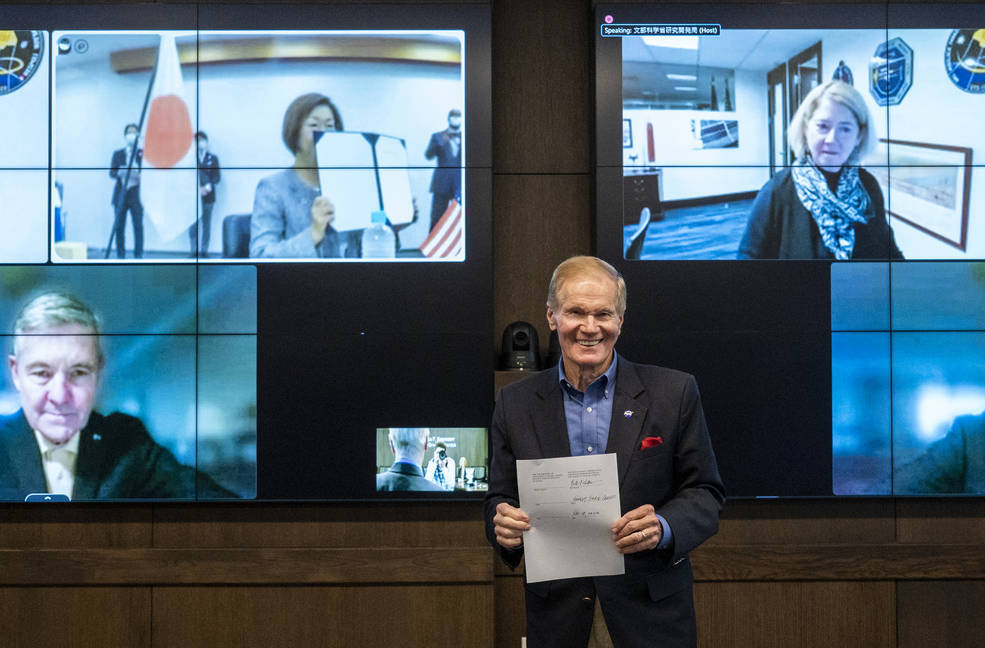19.11.2022

NASA and the Government of Japan on Thursday announced further contributions by Japan to Gateway, a key component of the agency’s Artemis missions for long-term lunar exploration. NASA Administrator Bill Nelson participated virtually from the agency’s Kennedy Space Center in Florida in an event held in Tokyo that included Minister of Education, Culture, Sports, Science and Technology Keiko Nagaoka, as well as U.S. Ambassador to Japan Rahm Emanuel.
Under the Gateway Implementing Arrangement, NASA will provide an opportunity for a Japan Aerospace Exploration Agency (JAXA) astronaut to serve as a Gateway crew member on a future Artemis mission. This formally represents the first commitment by the U.S. to fly a Japanese astronaut beyond low-Earth orbit aboard NASA’s Space Launch System (SLS) rocket and Orion spacecraft.
In addition to the Gateway arrangement, Minister Nagaoka announced Japan’s commitment to participate in the International Space Station Program through 2030, the first international partner to join the United States in formally committing to space station operations through 2030.
“The alliance between Japan and the United States is a cornerstone of peace, stability, and prosperity in the Indo-Pacific region and around the globe. Space cooperation is a critical component of our alliance. While I was in Tokyo in September, Prime Minister Kishida and I discussed our mutual interest in strengthening our cooperation in outer space across commercial, civil, and security sectors. And today, building off that and many other discussions between our governments, we are delivering results,” said Vice President Kamala Harris. “Japan’s contributions will advance scientific knowledge and protect our brave astronauts exploring the depths of outer space. And it brings us one step closer to one day having a Japanese astronaut walk on the Moon. Today we celebrate U.S.-Japan cooperation in space, which has never been stronger.”’
“For decades, Japanese and American astronauts have worked together to promote science and exploration in low-Earth orbit. Today’s Gateway agreement represents the fulfillment commitments made by the Biden-Harris Administration and solidifies our nations’ collaboration, which will help ensure continued discoveries on Gateway, the International Space Station, and beyond,” said Nelson. “There is no doubt that discovery strengthens the U.S.-Japanese partnership, and discovery strengthens democracy – in the Indo-Pacific and across the globe. With this agreement, the U.S. and Japan will create more well-paying jobs, more research and development capabilities, and a growing capacity to compete in the 21st century together.”
Japan’s contributions to Gateway include critical components of the International Habitation (I-HAB) module that will provide the heart of the Gateway space station’s life support capabilities, as well as space for crew to live, conduct research, and prepare for lunar surface activities during Artemis missions. Japan will provide I-HAB’s Environmental Control and Life Support System (ECLSS), thermal control system functions, and cameras.
Japan also will provide batteries for I-HAB, the Habitation and Logistics Outpost (HALO) module, the initial crew cabin for astronauts visiting the Gateway, and the European System Providing Refueling Infrastructure and Telecommunication (ESPRIT) refueling module.
In addition, Japan will provide the JAXA HTV-XG spacecraft for launch and delivery of a logistics resupply mission for Gateway, scheduled for no later than 2030.
Japan’s contributions to Gateway will support longer duration stays at the lunar-orbiting outpost, enabling successful Artemis missions that advance exploration and scientific research in deep space.
NASA’s Gateway Program is an international collaboration to establish humanity’s first space station around the Moon as an essential element of NASA’s Artemis missions. Gateway will provide many capabilities for sustained exploration and research in deep space, including docking ports for a variety of visiting spacecraft, space for crew to live and work, and onboard science investigations to study heliophysics, human health, and life sciences, among other areas. Gateway will be a critical platform for developing technology and capabilities to support future Mars exploration.
NASA welcomed Japan’s announcement of its continuation of space station operations through 2030. NASA and its international partners conduct critical science, research, and technology demonstrations aboard the orbiting laboratory that make long-duration missions to the Gateway and the Moon possible. Japan’s commitment to space station operations through 2030, along with the United States, will help continue maximizing humanity’s understanding of the human health challenges associated with spaceflight and prove the technologies that will be needed for deep space exploration. Such research benefits people on Earth and lays the groundwork for future human exploration beyond low-Earth orbit through the agency’s Artemis missions.
Quelle: NASA
